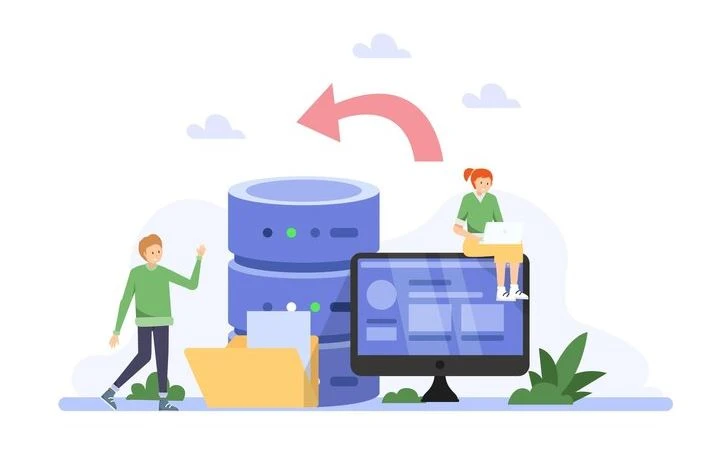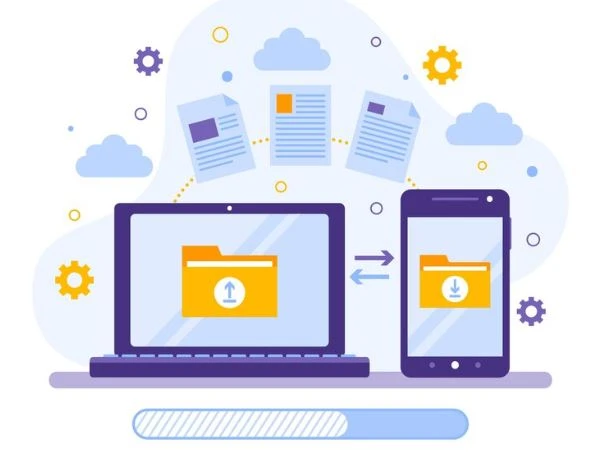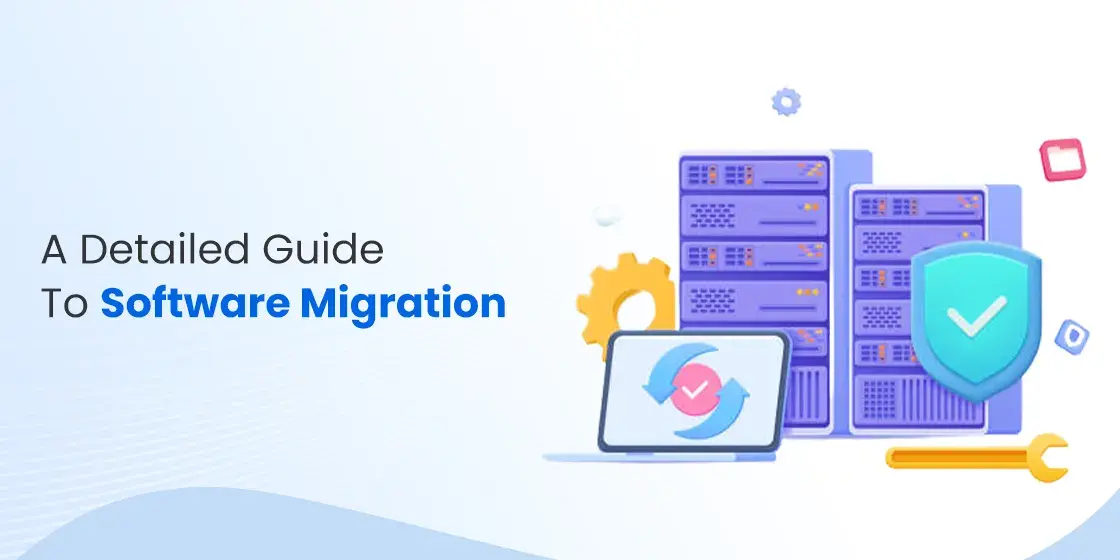Table of Content
Take a Look at the Types and Benefits of Software Migration Below
Software migration is a concept that should be understood properly. This process often becomes important for businesses that are facing issues in operating inside their current infrastructure. Their operational efficiency often becomes a big point of concern, limiting them to work in a slow manner. This problem forces them to think about transition towards cloud or any other advanced infrastructure. It is something that can happen at any time, hence businesses must need to keep themselves ready for any type of product migration.
To perform software migration properly, it is best advised to hire any specialized software development company from the market. Working with these agencies becomes quite beneficial, as they bring tons of experience in software development and migration. However, if you want to perform the process yourself, you’ll first need to acquire the complete technical knowledge of migration. This is important for beginners because they usually have a limited set of knowledge related to this process.
Getting a good understanding about migration is important because it involves various types of technicalities. In this blog, we will cover this topic in detail, so that you can understand how software migration is done utilizing different types of strategies and methods. Let’s first take a look at the definition of software migration, and the reasons why it is considered important for businesses.
What is Software Migration?

Software migration refers to the process of transferring or moving a software application or system from one environment to another. This can involve various elements, such as data, hardware, operating systems, or even cloud platforms. The need for software migration often arises due to technological advancements, changes in business requirements, or the desire to enhance the performance and capabilities of the software. It is a strategic decision made by organizations to ensure that their software remains up-to-date, compatible with new technologies, and aligned with evolving business objectives.
The process of software migration involves several key aspects. First and foremost is data migration, where existing data is transferred and adapted to the new system or environment. This requires careful planning to ensure data integrity and consistency. Next, there is code migration, involving the adaptation of the software code to function seamlessly in the new environment. This may require modifying or rewriting parts of the code to align with the operational requirements of the target system. Additionally, migration often involves testing to identify and resolve any issues that may arise during or after the migration process.
While software migration offers benefits such as improved, it also presents challenges. These challenges include potential disruptions to business operations during the migration process, the need for extensive testing, and the possibility of data loss or corruption. However, overcoming these cloud migration challenges can result in a more robust and efficient software system that meets the current needs of the organization. Successful software migration requires careful planning, collaboration between various stakeholders, and a thorough understanding of both the existing and target environments.
Importance of Software Migration

Software migration is a critical process for businesses that can significantly impact their efficiency, competitiveness, and overall success. As technology rapidly evolves, businesses must adapt and upgrade their software systems to stay current and take advantage of the latest features and capabilities. The importance of software migration lies in its ability to enhance productivity, streamline operations, and ensure that organizations remain agile in an ever-changing digital landscape.
Firstly, software migration allows businesses to leverage the latest technological advancements, leading to improved performance and functionality. Upgrading to newer software versions or migrating to more advanced platforms often results in enhanced speed, security, and scalability. This can lead to increased efficiency in daily operations, reduced downtime, and improved response reaction. Additionally, updated software may offer new features that enable organizations to meet evolving customer demands, comply with industry regulations, or address emerging market trends.
Secondly, software migration is essential for maintaining security and compliance standards. Older software versions may become vulnerable to security threats as they lack the latest patches and updates. This exposes businesses to potential data breaches, compliance violations, and reputational damage. Migrating to newer, more secure software helps organizations stay ahead of cyber threats, safeguard sensitive information. By prioritizing security through software migration, businesses can build trust with customers, partners, and stakeholders, fostering a secure and reliable digital ecosystem.
Types of Software Migration

Being a software development head of administrator, you must need to know different types of migration. A lot of people think that migration only refers to the transition process of a software. Well, that is certainly not true, as it can involve different other components as well. If you do not know much about them, lets take a quick look at the types defined below.
Database Migration
Database migration refers to the process of transferring data from one system to another using database migration tools. This can occur for various reasons, such as upgrading to a new version of the database software, changing to a different database management system (DBMS), or consolidating data from multiple sources into a single database. The primary goal of database migration is to ensure a smooth transition with minimal disruption to ongoing operations while preserving the integrity and consistency of the data.
The migration process typically includes several key steps, such as assessing the current database structure, mapping data relationships, and defining the target database schema. Database administrators also need to consider potential differences in data types, constraints, and other features between the source and destination databases. To mitigate risks and ensure data accuracy, thorough testing is essential before and after the migration.
Fuel innovation by leveraging bespoke software solutions. Get in touch with our team of experts to build cutting-edge software products.
Get a QuoteServer Migration
Server migration refers to the process of relocating or transferring the entire set of data, applications, and configurations from one server to another. This migration can be motivated by various factors, including hardware upgrades, server consolidation, data center relocation, or a shift to a more advanced infrastructure. The objective is to ensure a seamless transition while minimizing downtime and potential disruptions to services.
The server migration process in completed in different steps, including server environment analysis, identifying dependencies, and designing a migration plan. Data backup is a critical element to mitigate the risk of data loss during the migration process. Depending on the scale of the migration, strategies such as virtualization, physical-to-virtual (P2V) or virtual-to-virtual (V2V) migrations, and replication technologies may be employed.
Cloud Migration
Cloud migration refers to the process of transferring an organization’s digital assets, such as applications, data, and IT resources, from on-premises infrastructure or traditional hosting environments to cloud-based services. The primary goal of cloud migration is to leverage the scalability, flexibility, and cost-efficiency offered by cloud computing platforms. This transition allows businesses to reduce the need for physical maintenance, enhance agility of the whole system perfectly.
The cloud migration process involves various stages, including assessment, planning, migration, and optimization. In the assessment phase, organizations evaluate their existing infrastructure, applications, and data to determine their compatibility with cloud services. The planning phase involves migration strategy, cloud service models usage, and establishing appropriate security and compliance measures by working with the right cloud adoption framework.
Infrastructure Migration
IT infrastructure migration refers to the process of transferring an organization’s entire information technology (IT) infrastructure, including hardware, software, networks, and data, from one environment to another. This migration may involve moving from on-premises data centers to cloud-based services, upgrading to new hardware, or transitioning between different IT environments. The primary objectives of IT infrastructure migration are to improve efficiency, scalability, and agility while meeting the evolving needs of the business.
The IT infrastructure migration process typically begins with a thorough assessment of the existing infrastructure, including hardware, software applications, and data dependencies. A comprehensive migration plan is then developed, detailing the steps to be taken, potential challenges, and risk mitigation strategies. The migration itself involves transferring data, configuring new hardware and software, and validating that the migrated infrastructure meets performance and security requirements.
Things to Consider Before Starting Software Migration

Software migration is a lengthy process, hence you should build a roadmap first before executing any job. There are a few things you need to remember before starting the migration process. These are often called pre-migration steps that ensures smooth and clear data transition all the way. Let’s take a quick look at them below.
Evaluating the Data
When starting software migration, the initial step involves conducting a comprehensive pre-migration assessment of both the software and data earmarked for relocation. This assessment is crucial for gaining insights into the underlying reasons propelling the migration, demanding a clear articulation of objectives and a profound understanding of the entire migration process. To systematically approach this evaluation, it can be divided into two integral components.
Firstly, there is the need to intricately define the structural framework of the project migration, establishing a definite roadmap that outlines the sequence and dependencies of tasks. This initial phase serves as the blueprint for the subsequent stages of the migration endeavor. Simultaneously, the second aspect of the pre-migration evaluation involves delving into the technical intricacies specific to the given case.
Complete Data Clean-up
Another critical aspect to consider is the meticulous examination of data quality and the imperative task of cleansing it in preparation for migration. This involves a dual focus on different types of data that are residing in the application. To address this concern, a comprehensive analysis is necessary to identify instances of insufficient data, necessitating manual rectification or the development of an automated tool specifically tailored for this purpose.
The significance of pre-migration data cleaning cannot be overstated, as it serves as a crucial process in mitigating risks associated with system malfunction or errors post-migration. An additional dimension to this process involves accessing the data and meticulously mapping it into the new system, aligning it with the specified functional requirements. This proactive approach not only enhances data quality but also significantly reduces the risks of project overruns.
Plan the Migration Pathway
Embarking on software migration provides an opportunity to thoroughly reassess the entirety of business processes. This involves a comprehensive analysis to ascertain if existing processes can be optimized for greater efficiency. Crucially, this evaluation should be conducted prior to initiating data migrations. This preemptive understanding ensures that the business processes align cohesively with the requirements of the impending software migration.
Simultaneously, the strategic planning for software migration extends to defining the technological stack that will be employed throughout the migration process. Different migration scenarios and business goals dictate the need for specific migration tools, and there is no one-size-fits-all solution. When selecting software, crucial factors such as security, scalability, pricing, performance, and integrity must be carefully considered to tailor the technology stack to the unique requirements of the migration.
Testing the Migration Process
Software migration is a difficult task that should not be done according to assumptions. You should have a clear understanding of the process, in fact, a solid prior experience. Those who are doing it for the first time, should test out their strategy and model first. They need to create a plan that exhibits real time scenarios, involving source/target destinations, required data sets, migration tools and more others. This showcases a good practice for those who are doing migration for the first time.
At the same time, the knowledge of day-to-day operations in the ongoing system is also important for administrators. A perfect migration process should not disrupt anything in the routine operations. So, it is quite important to test a migration strategy that can work side by side with the ongoing system functions. This could be done by running prior tests, so that smooth migration can be done in the live environment.
Benefits of Software Migration

Software migration brings plenty of benefits for the businesses. It comes handy for those who are struggling with the infrastructural problems, especially related to database and server hosting. Being a product administrator, you should know the areas where migration could bring improvement effectively. Let’s take a look at the some of the key benefits of software migration below.
Improved Performance
This migration serves as a transformative step, contributing to an overall improvement in software performance. The adoption of modern technology facilitates faster data processing, enabling applications to respond promptly to user inputs and demands. It works perfectly for legacy systems that are in a dire need of performance boost.
The shift to modern tech infrastructure not only optimizes the operational aspects of software but also addresses the evolving needs of businesses in an increasingly dynamic digital landscape. Beyond mere performance improvements, this migration fosters adaptability and scalability, crucial factors for organizations navigating a rapidly changing technological environment.
Platform Scalability
One of the most significant benefits of migration, particularly when transitioning to a cloud platform, lies in the enhanced scalability it affords. The ability to scale resources up or down according to fluctuating requirements represents a distinct advantage. It sets apart these platforms from outdated systems that lack such adaptability.
The advantages of scalability extend beyond immediate flexibility and cost-effectiveness. In a rapidly changing business landscape, where the volume and nature of data processing can vary significantly, scalability becomes a strategic asset. It does not bind organizations with limited resources, instead, offers them lucrative ways to modify resources anytime.
Cost Reduction
Software migration to the cloud can contribute significantly to cost cutting through various mechanisms. Firstly, cloud services operate on a pay-as-you-go or subscription model, allowing organizations to pay only for the resources they consume. This eliminates the need for large upfront investments in physical infrastructure and reduces ongoing operational expenses.
Furthermore, cloud providers often offer economies of scale, as they aggregate resources and share infrastructure across multiple clients. This shared model results in lower costs for hardware, software, and maintenance, which are distributed among a broader user base.
Frequently Asked Questions
| What is software migration? Software migration refers to the process in which you migrate a software from one infrastructure to another. This is primarily done due to the inefficiencies occurring in the current platform. So, moving towards new platform often solves the problem of app performance and security. |
| Why software migration is important for companies? Software migration is crucial for companies to leverage modern technology and enhance operational efficiency. It enables the integration of advanced features, improved security, and scalability, fostering innovation and sustained growth. |
| How many types of software migration are there? Software migration includes different types of components transition. It includes database migration, operating system migration, IT infrastructure migration and more others. |
Final Words
That takes us to the end of this blog in which we have discussed about software migration in detail. Being a software administrator, you should have a sound knowledge about the process of migration, because the possibility of transition can arrive anytime. Currently, companies are quickly migrating their products towards cloud, as they know the advantages of using this futuristic platform. This blog is therefore written to let you understand how software migration should be done keeping all the important things in mind.
Meanwhile, if you are looking for a company that could help you to build quality software solutions, get in touch with us today. We will assist you to develop advanced software products, rightly as per the needed requirements.
Empower your digital initiatives with BariTechSol, a premier custom software development company. Our skilled team tailors cutting-edge solutions to your unique needs. Elevate your tech experience and stay ahead in the digital realm. Partner with BaritechSol and code the success of your next big idea.


